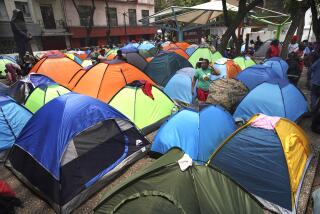Coronavirus slashing money immigrants send home by 20%, creating second economic crisis

- Share via
In a second-story storefront in an Artesia shopping mall, Andrea Luchavez slid $500 in cash beneath a cashier’s window to a teller who would wire the funds to her children and mother in the Philippines.
It was $300 less than what Luchavez sent every month, before the coronavirus paralyzed Southern California and the world, putting millions out of work, including her husband, and paring back the hours of those who, like her, managed to keep their jobs.
Each year, immigrants such as Luchavez collectively send hundreds of billions of dollars from the countries where they work to those they call home. These remittances are a lifeline for individual families and some national economies, accounting for a fifth of El Salvador’s and Honduras’ gross domestic product, and more than a third of Haiti’s.
But the COVID-19 pandemic, which has wiped out service industry and construction jobs commonly held by immigrants, will sharply curtail their ability to remit money, according to a report published Wednesday by the World Bank. Remittances will fall by 20%, from $554 billion in 2019 to an expected $445 billion this year, the report said.
Writ large, World Bank economists and other experts say, such an unprecedented decrease in remittances will deal a gut punch to developing countries’ GDPs and strain their social safety nets. For individual families, it could be catastrophic.
Luchavez, who works as a caregiver, said her hours have been cut from 40 to about 24 a week. Her husband lost his job. She went to a food bank in Cerritos last week, a first in her 15 years in the United States.
She is sending less money to her family, who live in Santa Rosa, a city of about 350,000 south of Manila, precisely when they need it most, she said. Because the city is locked down, its residents under curfew, Luchavez’s college-aged children cannot work and have no source of income but the money she sends them, she said.
Historically, remittances have helped developing countries weather shocks, such as natural disasters or civil unrest, said Dean Yang, an economics professor at the University of Michigan who has studied the flow of remittances to the Philippines. When a prolonged drought gutted the Philippines’ agricultural sector in the 1990s, Yang said, families with relatives working abroad were able to replace about 60% of income lost to the crisis through remittances.
But “this is an unusual crisis,” he said, “in that the whole world is suffering.”
Since the World Bank began tracking remittances in 1980, the only crisis comparable to this one is the 2008-2009 financial crisis, said Dilip Ratha, an economist for the bank and one of the authors of its report. At that time, Ratha told reporters on a conference call Tuesday, remittances decreased by just 5%.
Even as they plummet, remittances will become more important than ever to low- and middle-income countries, Ratha said. Foreign direct investment to those countries will decrease this year an estimated 37%, outstripping the expected decline in remittances, the World Bank predicts. Last year, more money flowed to low- and middle-income countries in remittances than foreign direct investment. With the pandemic, “the gap will become even wider,” Ratha said.
While the virus has disrupted daily life unlike anything in recent history, Hugues Efole, who leads business development for the Americas for MoneyGram, one of the world’s largest money transfer companies, said he believes the flow of remittances will stabilize.
Efole, who left the Democratic Republic of the Congo three decades ago and has sent money to family there ever since, said remittances are among the last things immigrants write out of their budgets in a crisis.
“They’re not something you pay for fun. It’s a necessity,” he said. “It’s ‘I’m in the United States because my family sacrificed for me and no matter what happens, I’m going to send that money home.’ It’s a cultural obligation.”
Plummeting remittances will deal a particularly sharp blow to Latin America, said Manuel Orozco, director of the Migration, Remittances and Development Program at the Inter-American Dialogue, a think tank in Washington, D.C. About 28 million migrants work overseas and remit money to the region, he said, and in Latin American families with a relative working overseas, remittances typically account for half their income.
In the last two weeks, Orozco said, the region has seen a “huge decline” in remittances from the United States in “a reflection of the shock of immediate job loss.” Many migrants in the United States work in the service industry and construction. More so than white-collar jobs, many of which can be performed from home, these sectors were devastated by stay-at-home orders intended to slow the spread of the virus.
While his typical workweek is now four days instead of five, Carlos Paz Cortez still has a job packing deliveries for a grocery and restaurant supplier in El Monte. After work on a recent afternoon, he walked to the city’s Valley Mall, dead quiet and shuttered but for two storefronts advertising money transfers. Paz Cortez wired $300 to his son, wife and sisters in Sonsonate, a city of about 70,000 in western El Salvador.
Paz Cortez sends that much every month, some months a bit more, others a bit less. For generations, a member of his family has lived in California and sent dollars home. His grandmother came first and sent money to his mother; his mother came when he turned 18 and sent money to him; Paz Cortez came in 2005 and has sent money to his wife and son ever since.
It is “100% important,” he said. Because of El Salvador’s strict curfews, his relatives cannot work, he said. “They’ve closed the economy, closed the country. No one is working right now.”
He is thankful he has a job, although he knows how quickly things can change. “We never know about tomorrow,” he said. “I just think about today.”
More to Read
Sign up for Essential California
The most important California stories and recommendations in your inbox every morning.
You may occasionally receive promotional content from the Los Angeles Times.










